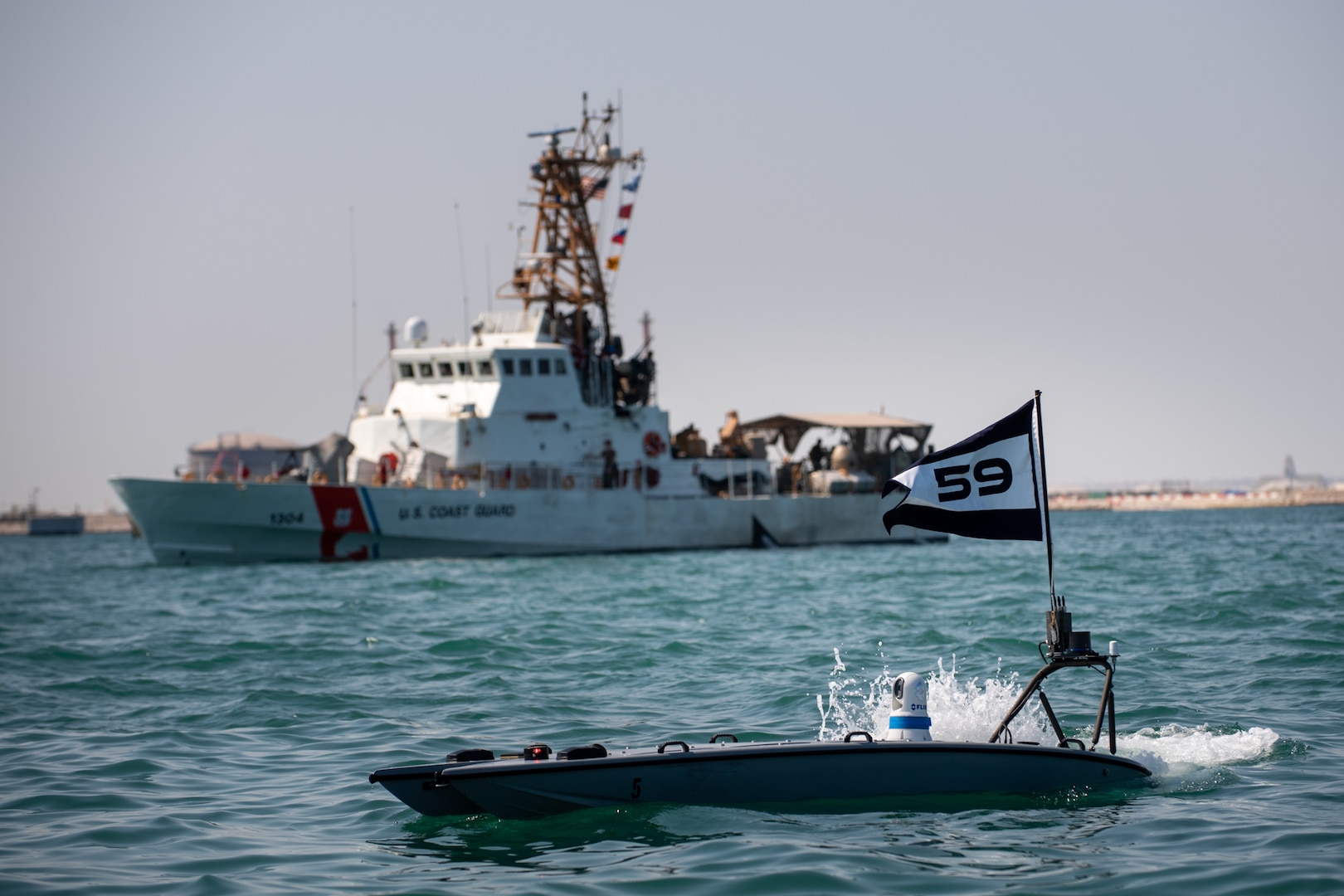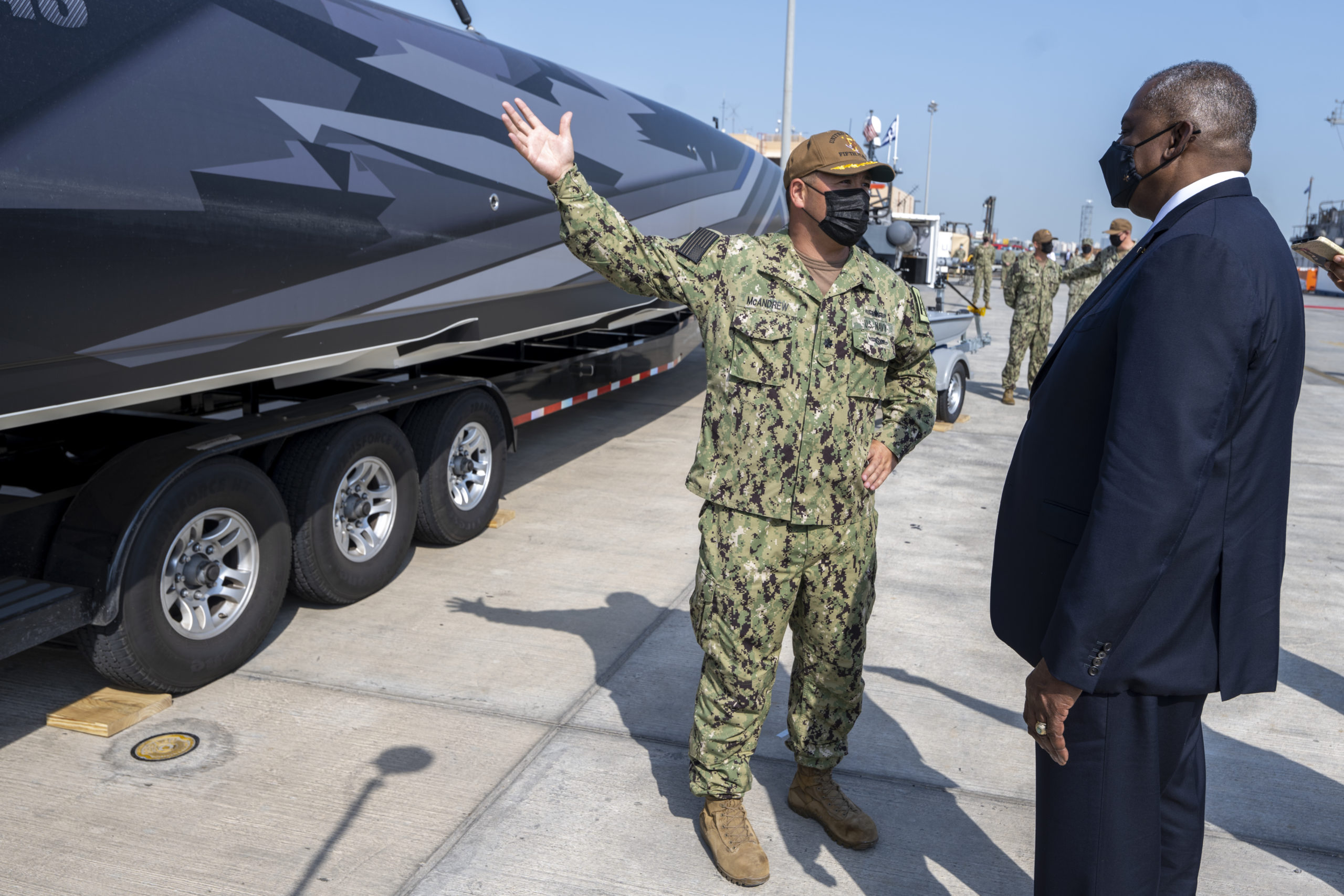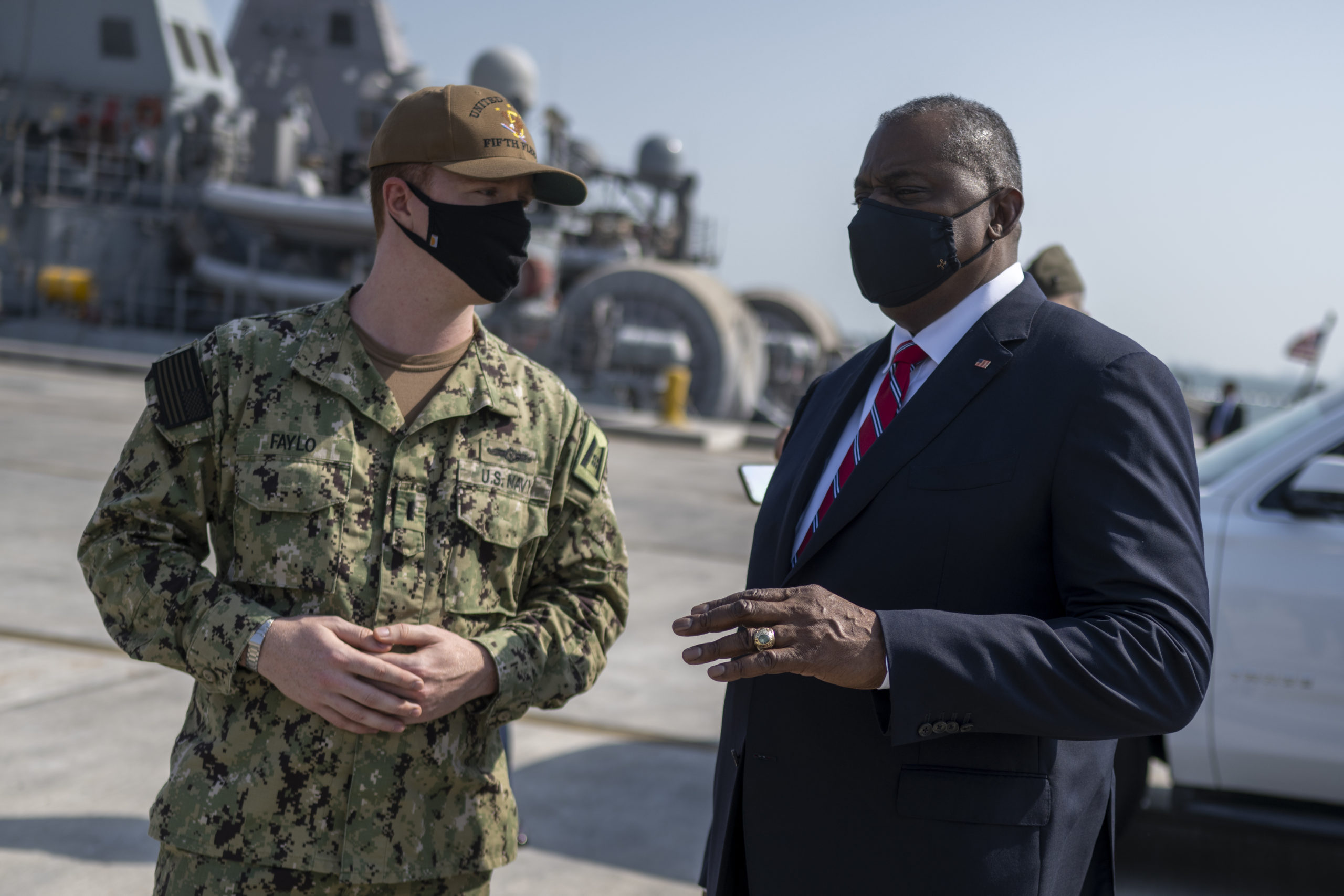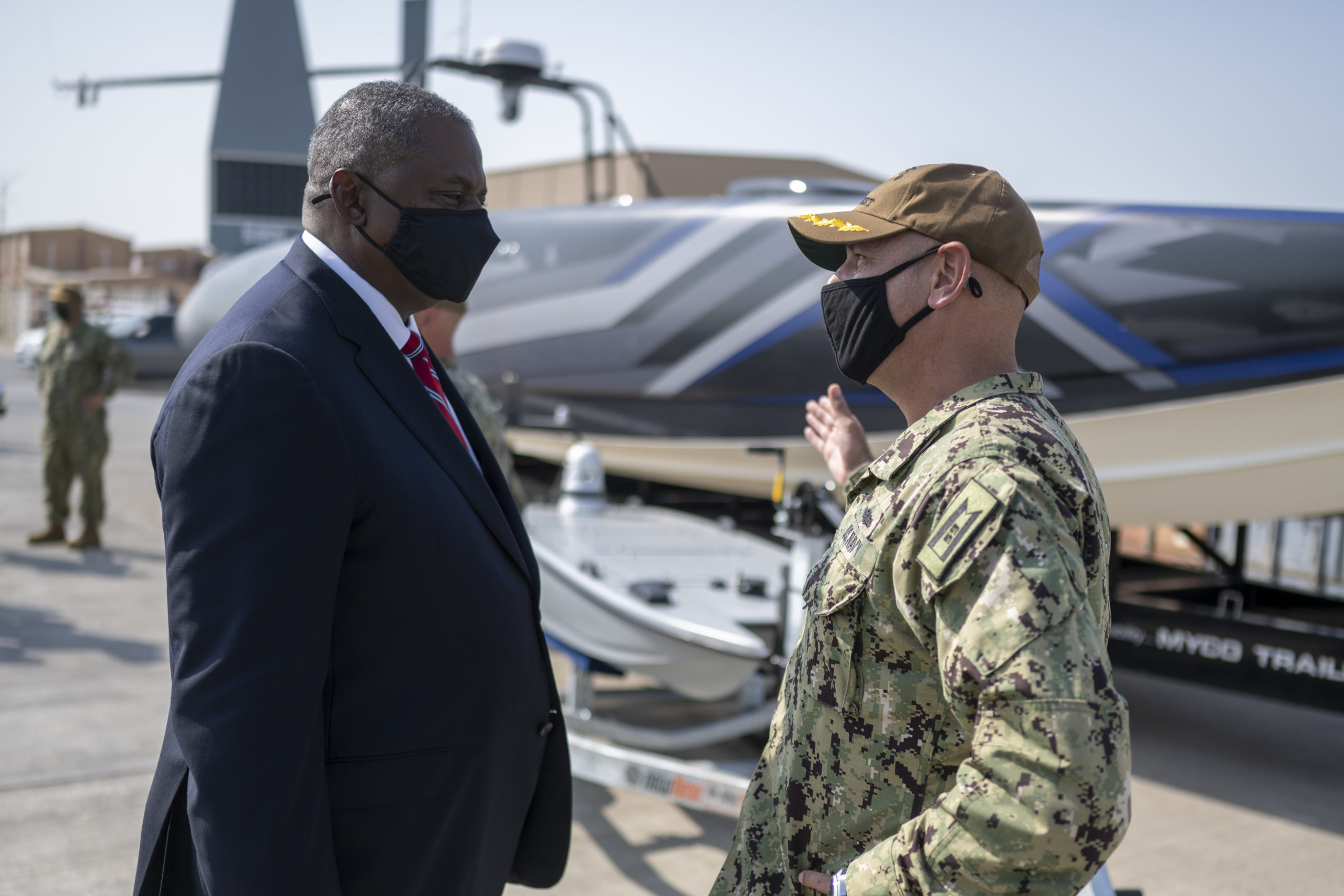By Robbin Laird
The recent formation of Task Force 59 by the U.S. Navy launches a significant way ahead in working a path for the introduction of maritime unmanned or autonomous systems.
And the main storyline or narrative to date has been just that.
This narrative was the main element of a story written by MC1 Roland Franklin and published on September 9, 2021 by the U.S. Navy:
U.S. Naval Forces Central Command (NAVCENT) established a new task force, Sept. 9, to rapidly integrate unmanned systems and artificial intelligence with maritime operations in the 5th Fleet area of operations.
Task Force 59 is the first U.S. Navy task force of its kind.
The U.S. 5th Fleet region’s unique geography, climate, and strategic importance offer an ideal environment for innovation.
“The bottom line on why we’re doing this is so that we can develop and integrate unmanned systems and AI as a means to do two things,” said Vice Adm. Brad Cooper, commander of NAVCENT, U.S. 5th Fleet and Combined Maritime Forces. “One, enhance our maritime domain awareness, and two, increase deterrence.”
Cooper also stated the task force would rely heavily on regional and coalition partnerships.
“The launch of Task Force 59 really invigorates our partnerships around this region as we expand our common operating picture.”
Cooper appointed Capt. Michael D. Brasseur, an expert in maritime robotics, as Task Force 59’s first commodore during a commissioning ceremony onboard Naval Support Activity Bahrain, Thursday. Brasseur served as a founding member of the NATO Maritime Unmanned Systems Initiative prior to arriving in Bahrain.
“It’s an honor to be named commander of this historic and innovative task force,” said Brasseur. “As we continue to adapt and implement cutting edge technology, I fully expect our talented team will enrich and enhance the 5th Fleet mission.”
Brasseur’s staff includes experienced operators with region-specific expertise, including directors for unmanned systems; unmanned exercises; task force integration; cyber, AI and space; and partnership opportunities.
In the coming weeks, the task force aims to build trust and confidence in human-machine teaming through a series of operations at sea. International Maritime Exercise (IMX) 22, slated for next year, will provide NAVCENT a real-world opportunity to demonstrate the resiliency and scalability of human-machine teaming technologies.
IMX-22 will include more than 60 nations and international organizations and features the extensive use of unmanned systems in various operational scenarios designed to challenge the technology in a dynamic environment and ultimately enhance partner capabilities through manned and unmanned teaming.
The U.S. 5th Fleet area of operations encompasses nearly 2.5 million square miles of water area and includes the Arabian Gulf, Gulf of Oman, Red Sea and parts of the Indian Ocean. The region is comprised of 21 countries and includes three critical choke points at the Strait of Hormuz, the Suez Canal and the Strait of Bab-al-Mandeb at the southern tip of Yemen.
And more recently, a 5th Fleet Public Affairs press release highlighted the completion of their first unmanned integrated exercise at sea.
On Oct. 26, U.S. Naval Forces Central Command (NAVCENT) completed exercise New Horizon, the first at-sea evolution for its new unmanned task force.
During the two-day training exercise, Task Force 59 integrated and evaluated new MANTAS T-12 unmanned surface vessels (USV) that operated alongside manned U.S. patrol craft and Bahrain Defense Force maritime assets.
This marked the first time NAVCENT integrated USVs with manned assets at sea in the U.S. 5th Fleet area of operations. New Horizon was also the first time for NAVCENT’s integration of USVs with manned assets at sea alongside partner forces.
“Working with our regional partners on unmanned systems integration is crucial to enhancing collective maritime domain awareness,” said Vice Adm. Brad Cooper, commander of NAVCENT, U.S. 5th Fleet and Combined Maritime Forces. “Bahrain, as our first regional partner to collaborate with Task Force 59 during an at-sea exercise, demonstrates the strengthening of our strategic relationship.”
The first phase of New Horizon, conducted Oct. 20, featured operators controlling the USVs aboard patrol coastal ship USS Firebolt (PC 10), while the vessels conducted high-speed maneuvers in formation.
The final phase on Oct. 26 brought together a larger force of manned and unmanned maritime and aerial assets from NAVCENT, the Royal Bahrain Naval Force (RBNF) and Bahrain Coast Guard. Participating units also included patrol boat USCGC Maui (WPB 1304), an SH-60S helicopter, a V-BAT unmanned aerial vehicle and RBNF patrol craft.
Both U.S. and Bahraini forces practiced operating the vessels in formation to strengthen mutual understanding and interoperability.
“This is a significant milestone for our new task force as we accelerate the integration of unmanned systems and artificial intelligence into complex, cross-domain operations at sea,” said Capt. Michael Brasseur, commander of Task Force 59. “Real-world evaluation is essential.”
NAVCENT established the task force Sept. 9. To focus U.S. 5th Fleet efforts on unmanned systems and artificial intelligence integration.
The U.S. 5th Fleet area of operations encompasses about 2.5 million square miles of water area and includes the Arabian Gulf, Gulf of Oman, Red Sea and parts of the Indian Ocean. The expanse is comprised of 21 countries and includes three critical choke points at the Strait of Hormuz, the Suez Canal and the Strait of Bab al Mandeb at the southern tip of Yemen.
Recently, the U.S. Secretary of Defense visited Bahrain to participate in an IISS meeting, and took time to learn about the efforts of Task Force 59 and that visit underscored the new efforts to integrate unmanned or autonomous systems. And without doubt this visit had an impact on his comments made later at the Reagan National Defense Forum this month.
During his engagement at the Forum he underscored that “the Department of Defense wants to be more capable of operating unmanned systems.” And the impact of the visit on his thinking seems obvious from this remark: “I was in Bahrain several weeks ago and saw how the Navy is doing innovative things with autonomous systems.”
He also underscored the importance of partners in shaping a way ahead for U.S. defense in the evolving strategic encironment.
It is at this point that I would like to focus on a different narrative one that in no way de-emphasizes the importance for the U.S. Navy or DOD working more effective ways to use unmanned or autonomous systems.
Rather, I would like to focus on where such efforts fit within the reshaping of the ISR enterprise which is being shaped by allies, partners, regional coalitions, and the U.S. joint force.
Too often the emphasis is upon what the United States can do rather than on the reshaping of regional coalitions of partners and allies and what they can do for themselves and how we can plug and play with their systems and find ways for such coalitions to be more effective themselves or how we can benefit from the evolution of those coalitions.
In my book with Murielle Delaporte, I focused on what we see is a key trend, namely, clusterizaiton of defense partnerships. This is how we put it in our book:
“Security threats have unleashed national reactions, with various nations seeking to rebalance their position in the global order and seeking to work with clusters of either like-minded states, or with states capable of providing key needs. Coalition defense in today’s world of defending the interest of “coalitions of the willing” of liberal democratic states is clearly about the exercise of effective operations in a semi-sovereign coalition environment as seen from a national perspective. It is not exactly the return of nationalism, for that has not been absent in any case, but is clearly the return of security and defense concerns as a priority, and these concerns are always led by states seeking allies, partners or friends, or “the enemy of my enemy is my friend” types of partners.”
And in that book, we highlighted a particularly important trend in terms of Nordic defense cooperation and one articulated by Harald Malmgren:
“A new cluster European nations with a common security objective have quietly emerged recently in the form of focused military cooperation and coordination among the Nordic nations, Poland, the Baltic States, and the UK. This cluster is operating in close cooperation with the US military. The Danes, Norwegians, the Swedes and Finns are cooperating closely together on defense matters. Enhanced cooperation is a response to fears of Russian incursions, which are not new, but have roots in centuries of Russian interaction with Northern Europe.”
For such clusters to operate together the key capabilities are shared C2 based on shared information, surveillance, and reconnaissance systems (traditionally known as intelligence, surveillance, and reconnaissance or ISR). It is here that new maritime autonomous systems can prove especially significance in working with the GCC and with those GCC states working within the framework of the Abraham accords with Israel as well.
How to generate ISR which can be shared? And shared in an environment of trusted information? Sharing common platforms in the unmanned surface vessel world and then shaping ISR and C2 payloads which can be deployed onboard provides an opportunity to then work the webs of information coming off these systems which can be shared.
It must be remembered that the Gulf is a narrow body of water with significant maritime traffic and the challenge in such circumstances is clearly to be able to distill information from noise. And to do so rapidly and among the cluster of states working together to shape common security or defense responses.
Working national systems to deliver effective information and intelligence is hard enough, doing so among partners in a security or combat cluster even more so. The advantage of shaping a common fleet of USVs is that is not just about 5th Fleet getting better; it is about the coalition of the willing learning to work together more effectively.
And not just for the U.S. or the coalition, but for the nations who are pursuing such USV ISR capabilities as well.
If one were to take the case of Bahrain, the Kingdom is investing significantly in the development scientific and technological capabilities to shape its future. Working in AI, digital systems, and ISR is clearly an area where local expertise and capabilities can be developed significantly to the benefit of Barthian and its partners.
The question then is how Bahrain can best work with like-minded partners to deliver more effectively ISR to the nation and at the same time leverage more effectively relevant capabilities which its partners posses as well.
How best to deliver an ISR cluster which can provide for enhanced security and defense for Bahrain and for the nations with which they work?
In other words, it is not just about developing new platforms, or simply new ways to work with unmanned or autonomous systems; it is about reworking how ISR clusters can be shaped and worked among those states willing to work together.
Featured Photo: A MANTAS T-12 unmanned surface vessel (USV), front, operates alongside U.S. Coast Guard patrol boat USCGC Maui (WPB 1304) during exercise New Horizon in the Arabian Gulf, Oct. 26. Exercise New Horizon was U.S. Naval Forces Central Command Task Force 59’s first at-sea evolution since its establishment Sept. 9. Photo by Petty Officer 3rd Class Dawson Roth and credited to 5th Fleet Public Affairs.
For our discussion of the evolution of European direct defense around the clusterizaiton dynamic, see the following:
For a discussion of the Abraham Accords and their impact, see our assessment in the following:





